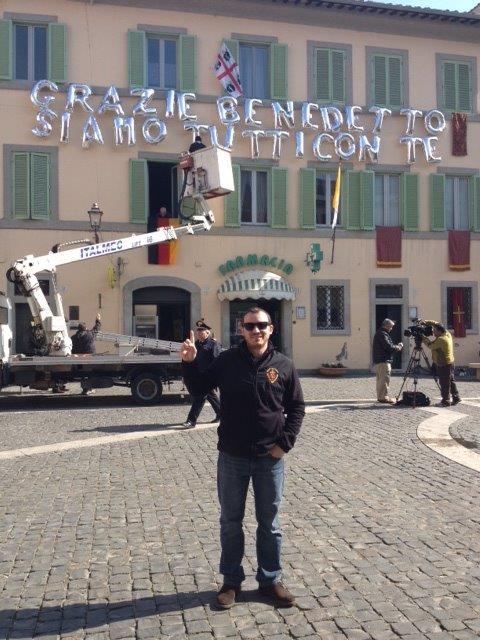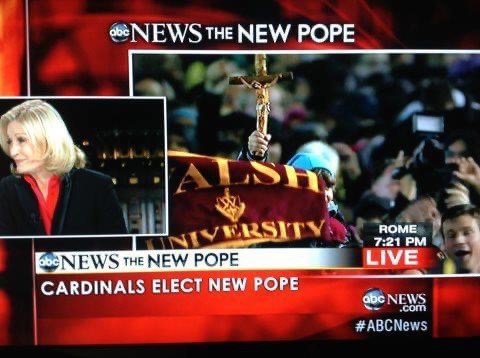Michael Cinson ’05
 Before being appointed to his current position as Director of Global Learning, Michael Cinson ’05 served as Walsh University’s Director of Student Life in Castel Gandolfo, Italy, from 2012-2016. He joined Walsh in 2007 as Residence Hall Director and was appointed Coordinator of Residence Education in 2010. Mike earned his Bachelor of Science degree from Walsh and his Master of Science in Education from the University of Central Arkansas.
Before being appointed to his current position as Director of Global Learning, Michael Cinson ’05 served as Walsh University’s Director of Student Life in Castel Gandolfo, Italy, from 2012-2016. He joined Walsh in 2007 as Residence Hall Director and was appointed Coordinator of Residence Education in 2010. Mike earned his Bachelor of Science degree from Walsh and his Master of Science in Education from the University of Central Arkansas.
When Michael Cinson accepted the position of Walsh’s Rome Director of Student Life in 2012, he had no idea he would have a front-row seat to not one, but two, significant milestones in Catholic history. Cinson and a group of Walsh global learning students led by Associate Professor of Chemistry Dr. Peter Tandler were witnesses to the last blessing of Pope Benedict and the first public appearance of Pope Francis.
On February 10, 2013, Pope Benedict XVI stunned the world with the announcement that he would resign at the end of the month. The move was virtually unprecedented, with every Pope since the early 15th century’s Gregory XII fulfilling their papal duties until death.
“I had started with the Fall I Program in 2012 and had only been in Italy a semester. I remember we were in the final stages of planning for the spring 2013 program when we heard of Pope Benedict’s resignation,” said Cinson. “The announcement was a huge surprise. I mean, no one saw this coming. We learned that Pope Benedict’s final week would coincide with the first week of our spring program in February. Then we heard that he was going to retire to the Pontifical Palace in Castel Gandolfo, which was where our Rome campus was located. The pieces just seemed to fall into place after that.”
For the Walsh students studying in Rome, Wednesdays are designed to be “down” days without any local travel plans. On Wednesday, February 28, the Walsh group heard Pope Benedict was arriving that day and decided to head to the Central Piazza to wait for him.
“We got there early in the morning and for a while we were the only people in the square. A lot of foreign press were there and they began to interview our students,” said Cinson. “By the time he arrived later in the day, the piazza had filled up. He arrived by helicopter and flew around the square while we all cheered in welcome, and then they landed in the gardens. After a few moments, Pope Benedict came out and greeted us. It was an incredible moment to be there in person for his last public blessing as Pope.”

Pope Benedict was emotional when he told the crowd, "I am simply a pilgrim beginning the last leg of his pilgrimage on this Earth.” At 8 p.m. that day, his resignation as Pope was official, marking the first time in 600 years a pontiff had resigned.
Soon to follow came the Papal Conclave to select the next Pope, which officially began a few weeks later on March 12. Gathering at the Vatican, 115 Cardinals sequestered under heavy security in the Sistine Chapel conducted secret votes to elect the Pope. No outside communication is allowed until a decision has been made.
During the Conclave, the world focuses its attention on the Chapel Chimney. Dating back to the 18th century, the Vatican communicates to the world whether or not a new Pope has been elected by releasing white or black smoke as the ballot sheets are burned.
“That evening, we all knew it would be black smoke. No one expected the new Pope would be selected that quickly. The next day, we had planned to be in the city and most of us wanted to go to the Vatican,” recalled Cinson. “We got there in the morning in time to see the black smoke. It was rainy that day and there weren’t that many people in the square because of the weather, so we decided to stay around for the afternoon votes.”
The afternoon came and went without a sign of smoke. As the day progressed, more people came into the square and spilled out onto the streets leading into the Vatican.
“Then we saw it – the white smoke. Because we were there so early, we had a pretty good location near the first barricade. The square went crazy with everyone cheering. But we had to wait as they prepared inside the Vatican for the Pope to speak,” said Cinson. “The Vatican Swiss Guard and the Order of the Household came out in front of St. Peter’s. We could see people inside the Vatican, gathering in all of windows and then the Cardinals came out and assembled together in their traditional garb, it was an incredible sight. All eyes went to Papal Balcony. It was just surreal.”
While there was much speculation among the crowd gathered, no one in the square knew with certainty who had been chosen by the Conclave.
“When the Dean of the College of Cardinals announced who had been elected, I was standing next to an Argentinian Priest. He heard the name ‘Jorge Bergoglio’ and began to celebrate. We had no cell phone connection in the square, so were still trying to figure out exactly who Jorge was when he finally made his appearance,” said Cinson. “I remember it was raining up until the moment he stepped out.”
During the international coverage of the announcement, St. Peter’s Square was filled with a display of various international flags, including one that read “Walsh University” held by the students. At home in the United States, the Walsh flag made a prominent appearance on Diane Sawyer’s ABC News coverage of the Conclave.
“It wasn’t until later that we realized Pope Francis hadn’t been wearing the things he normally would wear as Pontiff, that he had chosen to wear a simple white cassock and refused the customary gold cross offered to him,” said Cinson. “The moment that stands out the most though is when he started his address by asking for our prayers. Immediately, there was dead silence throughout the square as every one of us paused in our celebrating, bowed our heads, and prayed together for our new Pope.”
For Cinson, the highpoint was sharing both experiences with the students from Walsh.
“We actually witnessed history unfold in real time. As a Catholic university, I think the impact was even more profound for us all,” said Cinson. “I couldn’t have imagined designing a better Rome Experience for students during my first year in Italy.”